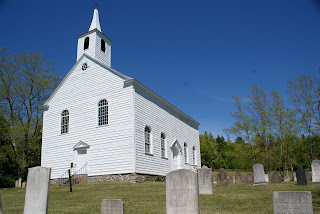Throughout the trip, we've been updating you on all of the nineteenth-century buildings that we've been visiting, but yesterday, we were lucky enough to visit three eighteenth-century buildings AND even more fortunately, we were able to get inside two of them! First was St Mary's Anglican, Auburn of 1790 which is what we might expect of a small eighteenth-century church; a James Gibbs-inspired preaching box complete with a Gibbsian spire and classical details.
Above: St Mary's Anglican, Auburn 1790
The interior is still in excellent shape and still retains its lovely gallery and lath and plaster barrel vault. More on this spectacular building next week in one of our building profiles. Thanks again to Roseann who kindly let us into the church and who gave us some wonderful background information.
Above: the interior of St Mary's Auburn, looking west
After this, we went to Middleton to check out Old Holy Trinity Church of 1789. We were intrigued by the authenticity of the Gothic details as its date would put it at one of the earliest (if not the earliest) examples of the Gothic style in Canada.
Above: Old Holy Trinity, Middleton 1789
Thanks to Brian, we were able to enter the church to check it out and to look for proof about the authenticity of the pointed windows on the facade. The interior has been well kept and we were able to determine that the Gothic windows were, in fact, original! Quite a find! The nave has been nicely restored as seen below. We will also feature this building in a more detailed building profile some time in the near future.
Above: the nave of Old Holy Trinity looking east
As icing on the cake, we were also able to see Old St Edwards Church in Clementsport of 1797. This classically-inspired church was a real beauty including a south-side pedimented entrance and Palladian eastern window, though sadly we couldn't get in.
Above: Old St Edwards Church, Clementsport 1797
It was a great day for very old buildings and also an excellent way to wrap up our visit to Nova Scotia. All in all we visited just over 50 buildings in seven days, so we will be filling you in on the rest of our finds in the next little while.























 Unfortunately we could not get inside this one, but we haven't given up yet - I am in the C-K area for the next 5 days and will keep trying - I bet it has an amazing open-timber ceiling in there...stay tuned for an update on that bet!
Unfortunately we could not get inside this one, but we haven't given up yet - I am in the C-K area for the next 5 days and will keep trying - I bet it has an amazing open-timber ceiling in there...stay tuned for an update on that bet! (Really I'm biased; I grew up down the street from the church...nostalgia, what a wonderful thing!)
(Really I'm biased; I grew up down the street from the church...nostalgia, what a wonderful thing!)












 Because, while on the trip, we saw Minke whales....
Because, while on the trip, we saw Minke whales.... ...dolphins...
...dolphins... ... and a whole lot of seals! Incredible!
... and a whole lot of seals! Incredible!
















